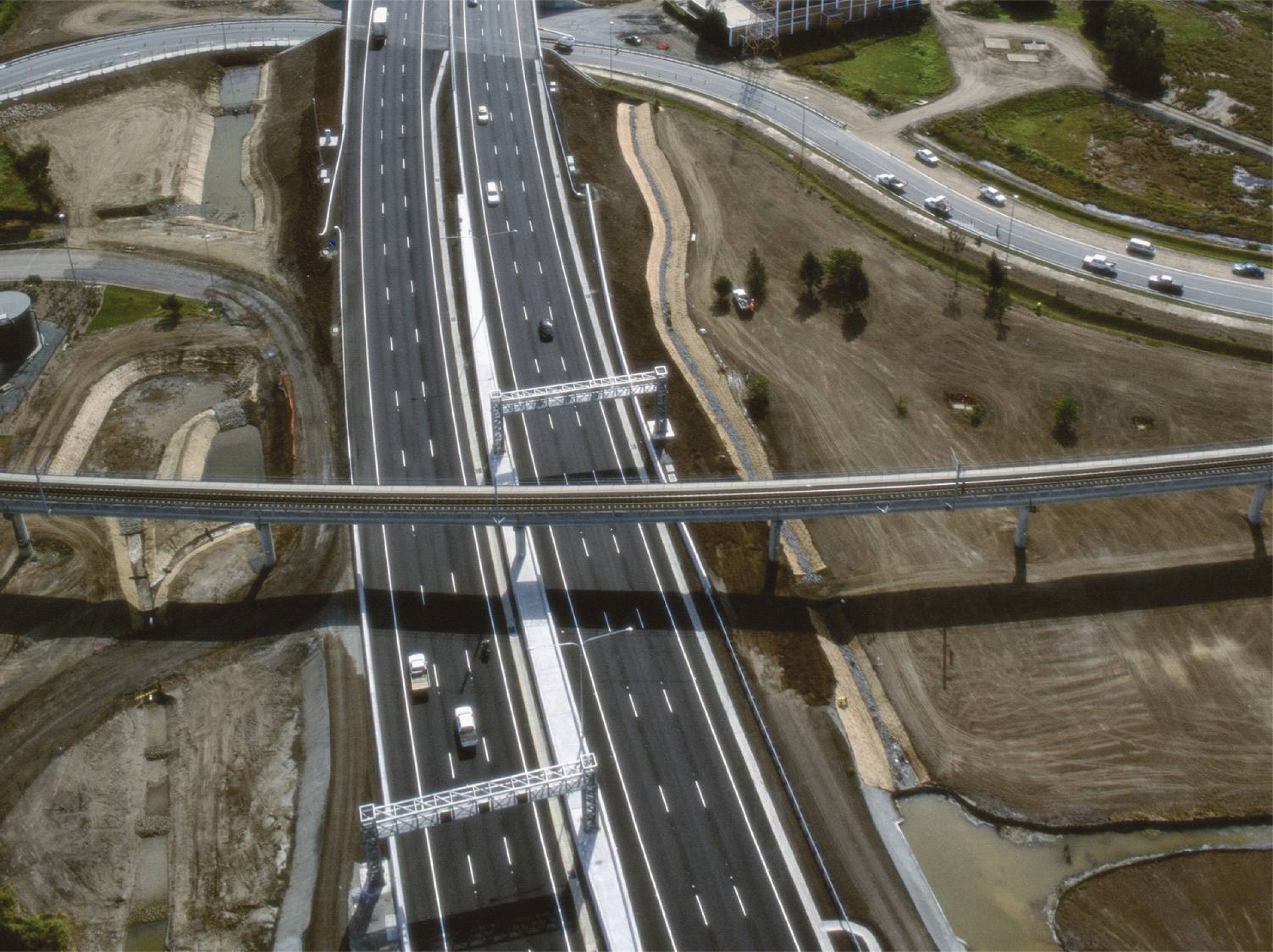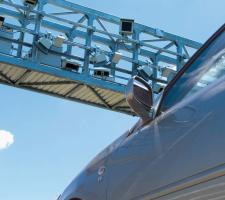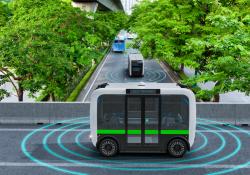
A total of 13 free-flown gantries were required, to be located close to the location of five existing toll points as well as on some on-ramps
By May this year, the new Gateway Bridge in Brisbane, which is being built alongside an existing bridge, will be open. With it will come an end-to-end free-flow tolling system. Interview with Sue Caelers, Queensland Motorway Ltd
821 Queensland Motorways Ltd owns and operates 61km of roadway in the area around Brisbane, Australia. This includes the Gateway Bridge and the Gateway Extension, Logan and Port of Brisbane motorways.
The Gateway Bridge opened in 1986 and since then congestion at its toll plaza has steadily increased. This has created safety issues and so in 2005 an A$1.88bn project was announced that would result in the bridge being duplicated and upgrades to 20km (12 miles) of the Gateway Motorway being completed. The Gateway Upgrade Project is being progressively delivered and each section is being opened to traffic as soon as it is completed; the new bridge is due to open in May this year. As a part of an expanded package of upgrades, the Queensland Government also directed that free-flow tolling be implemented across the network.
Queensland Motorways operates five tolling points, one of which is at the bridge itself. Prior to upgrade a hybrid Single-gantry solution
Queensland Motorways Ltd uses Vitronic's single-gantry TollCheckerfreeflow system. Vitronic markets that this as a complete solution for multilane freeflow tolling, without the need for in-road equipment. It combines vehicle detection, classification, communication and international license plate recognition. Vitronic states that all vehicles are reliably detected, even in dense traffic or while changing lanes. Flexible system design allows for multiple camera set-ups for different road formations and tolling modes.
TollCheckerfreeflow can be combined with a variety of payment methods and only when a non-payment is detected is a report generated and sent to the back office for further processing.
Both microwave and infrared DSRC communication modules that support international standards are integrated into TollChecker. Transactional and evidential data can be transferred to back office systems or to mobile enforcement vehicles through established communication technologies, and widely accepted cryptographic measures are used.
Identification Both tags and ANPR can be used to identify vehicles. Vitronic states that it can identify international and interstate license plates, even when colour plates are used; cameras, illumination and ANPR software are adapted from custom-designed modules to meet the highest performance requirements.
TollChecker also provides full 3D classification. Vehicle length, width and height, the number of axles and the presence of trailers are detected. Bicycle racks and roof boxes are identified and, as such, do not result in incorrect classification. The classification unit is non-intrusive and requires no in-road equipment. All types of lane layouts can be covered, independent of their number or width.cash/Electronic Toll Collection (ETC) system was in place. This suffered with many of the problems associated with legacy systems, not least of which was being a disconnected system incapable of tracking transactions from end to end, according to Sue Caelers, formerly Project Director for the Free-Flow Tolling Project and now Chief Information Officer with Queensland Motorways. The full extent of this remained unrealised until system improvements took place.
"We put out a request for interest in 2007 for both the roadside and central systems, and undertook reference site visits around the world," says Caelers. "This resulted in us shortlisting three providers for the roadside systems and three for the back office.596 Thales, with 147 Vitronic as a subcontractor, was selected to provide the roadside systems and gantries while 62 IBM was selected to deliver the central system.
For the free-flow part of the project, a total of 13 gantries were required. Production gantries were to be located close to the locations of the five existing toll points as well as on some on-ramps. In a first for Australia, a single-gantry design with significant levels of in-built redundancy was pursued. The design (see Sidebar, 'Single-gantry solution') included Optical Character Reading (OCR) at both the roadside and in the back office, the aim being to reduce manual image processing to the maximum possible extent.
Prior to system installation, a staging gantry was installed on-road and a development gantry was installed at Lakeside Park (a racetrack located at Pine Rivers to the north of Brisbane). Together, these were used to test performance in a variety of scenarios and to debug the system ahead of deployment. They also served to convince the state government of the need to invest in the solutions, Caelers says.
"There was an appreciable level of civil work involved in the conversion," she continues. "Two intersections on the Logan Motorway were of cloverleaf design with the toll plazas in the centre serving to slow traffic for entry and exit. With the plazas gone and traffic speeds at 100km/h (62mph) safety could again become an issue. Intersections were therefore upgraded before the transition to full diamond design and other rehabilitation work was also carried out, such as the extension of some on-ramps. The Logan Alliance delivered this work.
"The big thing to note is the delivery time for this work: just 17 months. The original tender document asked for the work to be completed by September 2009 but the state government brought this forward to July. This has been a very high-visibility project locally and has just one deliverable left - the commissioning of the tolling gantry on the new bridge when that opens in May this year."
To deliver the free-flow tolling project, a 50-strong development team from Queensland Motorways was co-located with vendors' staff in Brisbane and development work took place in both Australia and Europe. At the height of the project, over 100 people were involved.
Caelers: "During the cutover to free-flow, a couple of notable things happened. Thales had promised at the tender stage that gantry erection would involve road closures of no more than 15 minutes. In the event, the longest full road closure was for 20 minutes, so they were good to their word. Single-piece construction helped. Meanwhile, the Logan Alliance was completing plaza demolition work almost overnight. There's no real secret to how that was done, just good coordination.
"Data migration started well ahead of the cutover on 1 July last year. But we also needed to find a means of continuing to allow the use of cash. Our systems are ANPR-based, so we launched a series of products through a range of customer service channels including local retail outlets three weeks ahead of go-live. During this time customers were able to adjust to the new payment methods and channels while also giving us the opportunity to reinforce to customers that the time to pay with cash on the motorway was passing."
Plazas closed on 21 July last year. A two-hour transition was timed to start at midnight to minimise revenue loss.
"It wasn't a total technology risk," Caelers continues. "We conducted an expert assessment before selection and were happy that we'd get the performance we were after.
"A number of things drove selection. The reductions in infrastructure needs as a result of a single-gantry solution are obvious but the system also seemed to be more flexible to us. There's a lot of in-built sensor redundancy and the use of 3D modelling for classification gave us future-proofing - for instance, the state government has instructed us to change our current classification classes and we're in a position of being able to accommodate that.
Applicability to other traffic management systems was also a consideration and now we're looking for greater benefits realisation.
"We're looking to implement a series of ITS solutions along the Logan Motorway. Data gathering and predictive management will be combined with variable message signs and other information services for customers. The information we can glean from the gantries takes us a long way towards where we want to be in that respect."
In operation, there has been a process of continual improvement. OCR accuracy exceeds 90 per cent, as verified using large data sets and visual checks. Detection rates are stated to be in excess of 99.9 per cent and the redundancy built into the gantry system makes this possible.
"Also as a first, we're OCRing the state identifier, although there is the issue of many styles of personalised plates to contend with so the accuracy rates aren't as high as with licence plate numbers, but we're continuing to refine both the OCR engines and the supporting rules engines," says Caelers. "We take both front and rear captures and have both primary and secondary ANPR, so we have four potential ID sources per vehicle. That all supports our aim of least possible manual intervention.
"At present we issue free tags and have around 1.2 million out there now. We're almost at the point where ANPR is so effective that we can identify vehicles equally effectively whether by tag or LPN."
The Gateway Bridge opened in 1986 and since then congestion at its toll plaza has steadily increased. This has created safety issues and so in 2005 an A$1.88bn project was announced that would result in the bridge being duplicated and upgrades to 20km (12 miles) of the Gateway Motorway being completed. The Gateway Upgrade Project is being progressively delivered and each section is being opened to traffic as soon as it is completed; the new bridge is due to open in May this year. As a part of an expanded package of upgrades, the Queensland Government also directed that free-flow tolling be implemented across the network.
Queensland Motorways operates five tolling points, one of which is at the bridge itself. Prior to upgrade a hybrid Single-gantry solution
Queensland Motorways Ltd uses Vitronic's single-gantry TollCheckerfreeflow system. Vitronic markets that this as a complete solution for multilane freeflow tolling, without the need for in-road equipment. It combines vehicle detection, classification, communication and international license plate recognition. Vitronic states that all vehicles are reliably detected, even in dense traffic or while changing lanes. Flexible system design allows for multiple camera set-ups for different road formations and tolling modes.
TollCheckerfreeflow can be combined with a variety of payment methods and only when a non-payment is detected is a report generated and sent to the back office for further processing.
Both microwave and infrared DSRC communication modules that support international standards are integrated into TollChecker. Transactional and evidential data can be transferred to back office systems or to mobile enforcement vehicles through established communication technologies, and widely accepted cryptographic measures are used.
Identification Both tags and ANPR can be used to identify vehicles. Vitronic states that it can identify international and interstate license plates, even when colour plates are used; cameras, illumination and ANPR software are adapted from custom-designed modules to meet the highest performance requirements.
TollChecker also provides full 3D classification. Vehicle length, width and height, the number of axles and the presence of trailers are detected. Bicycle racks and roof boxes are identified and, as such, do not result in incorrect classification. The classification unit is non-intrusive and requires no in-road equipment. All types of lane layouts can be covered, independent of their number or width.cash/Electronic Toll Collection (ETC) system was in place. This suffered with many of the problems associated with legacy systems, not least of which was being a disconnected system incapable of tracking transactions from end to end, according to Sue Caelers, formerly Project Director for the Free-Flow Tolling Project and now Chief Information Officer with Queensland Motorways. The full extent of this remained unrealised until system improvements took place.
Going electronic
The move to free-flow operation involved removal of the cash toll plazas and replacement of the entire back office system."We put out a request for interest in 2007 for both the roadside and central systems, and undertook reference site visits around the world," says Caelers. "This resulted in us shortlisting three providers for the roadside systems and three for the back office.
For the free-flow part of the project, a total of 13 gantries were required. Production gantries were to be located close to the locations of the five existing toll points as well as on some on-ramps. In a first for Australia, a single-gantry design with significant levels of in-built redundancy was pursued. The design (see Sidebar, 'Single-gantry solution') included Optical Character Reading (OCR) at both the roadside and in the back office, the aim being to reduce manual image processing to the maximum possible extent.
Prior to system installation, a staging gantry was installed on-road and a development gantry was installed at Lakeside Park (a racetrack located at Pine Rivers to the north of Brisbane). Together, these were used to test performance in a variety of scenarios and to debug the system ahead of deployment. They also served to convince the state government of the need to invest in the solutions, Caelers says.
"There was an appreciable level of civil work involved in the conversion," she continues. "Two intersections on the Logan Motorway were of cloverleaf design with the toll plazas in the centre serving to slow traffic for entry and exit. With the plazas gone and traffic speeds at 100km/h (62mph) safety could again become an issue. Intersections were therefore upgraded before the transition to full diamond design and other rehabilitation work was also carried out, such as the extension of some on-ramps. The Logan Alliance delivered this work.
"The big thing to note is the delivery time for this work: just 17 months. The original tender document asked for the work to be completed by September 2009 but the state government brought this forward to July. This has been a very high-visibility project locally and has just one deliverable left - the commissioning of the tolling gantry on the new bridge when that opens in May this year."
To deliver the free-flow tolling project, a 50-strong development team from Queensland Motorways was co-located with vendors' staff in Brisbane and development work took place in both Australia and Europe. At the height of the project, over 100 people were involved.
Caelers: "During the cutover to free-flow, a couple of notable things happened. Thales had promised at the tender stage that gantry erection would involve road closures of no more than 15 minutes. In the event, the longest full road closure was for 20 minutes, so they were good to their word. Single-piece construction helped. Meanwhile, the Logan Alliance was completing plaza demolition work almost overnight. There's no real secret to how that was done, just good coordination.
"Data migration started well ahead of the cutover on 1 July last year. But we also needed to find a means of continuing to allow the use of cash. Our systems are ANPR-based, so we launched a series of products through a range of customer service channels including local retail outlets three weeks ahead of go-live. During this time customers were able to adjust to the new payment methods and channels while also giving us the opportunity to reinforce to customers that the time to pay with cash on the motorway was passing."
Plazas closed on 21 July last year. A two-hour transition was timed to start at midnight to minimise revenue loss.
System performance
The Vitronic single-gantry system can already be found in use in Germany as a part of the national truck tolling scheme there."It wasn't a total technology risk," Caelers continues. "We conducted an expert assessment before selection and were happy that we'd get the performance we were after.
"A number of things drove selection. The reductions in infrastructure needs as a result of a single-gantry solution are obvious but the system also seemed to be more flexible to us. There's a lot of in-built sensor redundancy and the use of 3D modelling for classification gave us future-proofing - for instance, the state government has instructed us to change our current classification classes and we're in a position of being able to accommodate that.
Applicability to other traffic management systems was also a consideration and now we're looking for greater benefits realisation.
"We're looking to implement a series of ITS solutions along the Logan Motorway. Data gathering and predictive management will be combined with variable message signs and other information services for customers. The information we can glean from the gantries takes us a long way towards where we want to be in that respect."
In operation, there has been a process of continual improvement. OCR accuracy exceeds 90 per cent, as verified using large data sets and visual checks. Detection rates are stated to be in excess of 99.9 per cent and the redundancy built into the gantry system makes this possible.
"Also as a first, we're OCRing the state identifier, although there is the issue of many styles of personalised plates to contend with so the accuracy rates aren't as high as with licence plate numbers, but we're continuing to refine both the OCR engines and the supporting rules engines," says Caelers. "We take both front and rear captures and have both primary and secondary ANPR, so we have four potential ID sources per vehicle. That all supports our aim of least possible manual intervention.
"At present we issue free tags and have around 1.2 million out there now. We're almost at the point where ANPR is so effective that we can identify vehicles equally effectively whether by tag or LPN."














